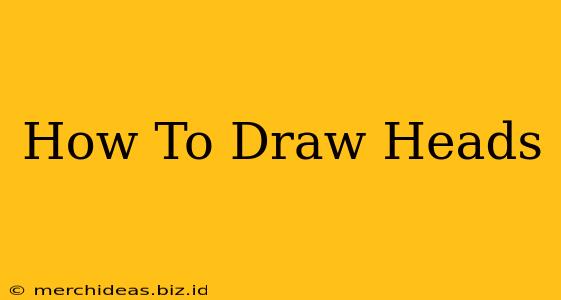Drawing realistic heads can seem daunting, but with the right approach and practice, it's a skill anyone can master. This guide breaks down the process into manageable steps, perfect for beginners. We'll cover fundamental shapes, proportions, and techniques to help you create expressive and lifelike portraits.
Understanding Basic Head Proportions
Before diving into details, grasping the fundamental proportions of a head is crucial. Think of the head as a simple shape – an egg or a slightly rounded square – to start. This provides a foundational structure upon which to build.
Key Proportional Guides:
- The center line: Draw a vertical line down the center of your head shape. This helps maintain symmetry and guides the placement of features.
- The eye line: This horizontal line sits roughly halfway down the head shape. The eyes are usually placed along this line.
- The nose line: This line is roughly halfway between the eye line and the bottom of the chin.
- The mouth line: This sits roughly halfway between the nose line and the bottom of the chin.
Remember, these are guidelines, not rigid rules. Facial features vary greatly, so observe your subject carefully and adjust accordingly.
Constructing the Head: From Basic Shapes to Details
Now, let's build upon that basic shape.
1. The Basic Shape:
Start with your chosen basic shape (egg or rounded square). This acts as your foundation. Lightly sketch it; you can refine it later.
2. Adding Construction Lines:
Add your center line, eye line, nose line, and mouth line. These lines are your roadmap, ensuring even placement of features.
3. Defining Features:
- Eyes: Observe the shape of the eyes carefully. Are they almond-shaped? Round? Pay attention to the eyelids, eyelashes, and the subtle details within the eye itself.
- Nose: The nose is a complex feature. Start by sketching its basic shape: a triangle, a rounded shape, or a combination. Consider the bridge, tip, and nostrils.
- Mouth: The mouth can express a wide range of emotions. Focus on the shape of the lips, their thickness, and the subtle curves.
- Ears: Ears vary significantly in shape and size. Pay attention to their placement on the sides of the head.
- Hair: Consider the hairline, the direction of hair growth, and the overall texture and volume of the hair.
4. Refining the Form:
Once you've positioned the main features, start refining the shapes. Gradually add details and soften harsh lines.
Essential Techniques for Realistic Portraits
Several techniques enhance realism in your head drawings:
1. Value and Shading:
Understanding light and shadow is crucial. Observe how light falls on the face, creating highlights and shadows. Use shading to create depth and dimension.
2. Perspective and Angles:
Practicing drawing heads from different angles helps you understand how features change based on perspective.
3. Practice and Observation:
The key to improving your head drawing skills is consistent practice and observation. Draw from real life as much as possible, paying close attention to detail. Study photographs and other artworks for inspiration and guidance.
Mastering the Art of Drawing Heads: A Continuous Journey
Drawing heads is a journey, not a destination. Consistent practice and dedication will gradually enhance your skills and allow you to create stunning and expressive portraits. Embrace the learning process, experiment with different techniques, and never stop observing the human form. Remember, the more you draw, the better you will become.
